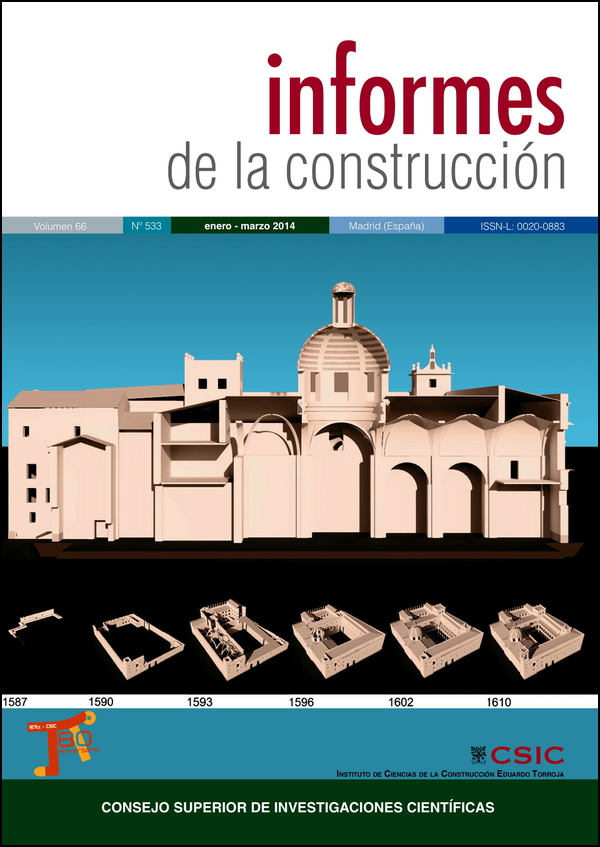Seismic study in masonry aggregated buildings using the capacity spectrum method
DOI:
https://doi.org/10.3989/ic.11.002Keywords:
Aggregated buildings, masonry, seismic damage, capacity curve, damage probability matricesAbstract
In this work a study about the seismic behaviour of a set of masonry aggregates buildings located in the city of Barcelona, Spain, is presented. Considering the age of these buildings (more than 70 years) two mechanical properties for the masonry were defined. The seismic action considered is defined by elastic response spectrum defined by Eurocode 8 for the seismic acceleration of Barcelona. To analyze these buildings the capacity spectrum method was used, from which the capacity curve and the fragility curves are obtained for evaluating the seismic expected damage. Damage probability matrices quantified the seismic damage and they are obtained from the fragility curves and the performance point. Considering that the city of Barcelona is located in an area of low seismicity, the results show an important seismic damage.
Downloads
References
(1) Yépez, F. (1996). Metodología para la evaluación de la vulnerabilidad y riesgo sísmico de estructuras aplicando técnicas de simulación (Tesis Doctoral). Universidad Politécnica de Cataluña, Barcelona, España.
(2) Mañà, F. (1997). Vulnerabilitat sísmica dels edificis de la ciutat de Barcelona, 98 pp. Insititut de Tecnología de la Construcció de Catalunya. Barcelona, España.
(3) Moreno, R., Bonett, R., Barbat, A., Pujades, L., Penna, A. y Lagomarsino, S. (2003). Evaluación de la vulnerabilidad sísmica de estructuras de mampostería no reforzada. Aplicación a un edificio de la zona del Eixample de Barcelona, España. Revista Internacional de Ingeniería de Estructuras, 8(2): 91-120.
(4) Moreno, R., Bairán, J., Pujades, L., Aparicio, A. y Barbat, A. (2004). Evaluación probabilista del comportamiento sísmico de edificios porticados de hormigón armado. Hormigón y Acero, 231: 125-136.
(5) Mena, U. (2002). Evaluación del riesgo sísmico en edificios en zonas urbanas. (Tesis Doctoral). Universidad Politécnica de Cataluña, Barcelona, España.
(6) Barbat, A.H., Pujades, L.G., Lantada, N., Moreno, R. (2006). Performance of buildings under earthquake in Barcelona, Spain. Computer-Aided Civil and Infrastructure Engineering, 21(8): 573-593. Erratum (2010). 25(3): 226. http://dx.doi.org/10.1111/j.1467-8667.2010.00660.x
(7) Lantada, N. (2007). Evaluación del riesgo sísmico mediante métodos avanzados y técnicas GIS. Aplicación a la ciudad de Barcelona (Tesis Doctoral). Universidad Politécnica de Cataluña, Barcelona, España.
(8) García Espuche, A. (1990). El quadrat d’or. centre de la Barcelona modernista. La formació d’un espai urbà privilegiat. Olimpiada cultural Barcelona’92. Lunwerg Editores, 315 pp.
(9) Paricio, A. (2001). Secrects d’un sistema constructiu: l’Eixample. Universidad Politécnica de Cataluña. Ediciones UPC, Barcelona.
(10) NCSE-02: Normativa «Norma de Construcción Sismorresistente: Parte General y Edificación», Real Decreto 997/2002, Boletín Oficial del Estado: 244, Madrid, (2002).
(11) EC-8: Eurocode 8 (2004). Design of structures for earthquake resistance – Part 1: General rules, seismic actions and rules for buildings. Comité Européen de Normalisation. EN 1998-1:2004, CEN Brussels, December, 229 pp.
(12) Galasco, A., Lagomarsino, S. y Penna, A. (2002). TreMuri Program: Seismic Analyzer of 3D Masonry Buildings. Technical Report, Universitat degli Studi di Genova, Italia.
(13) Moreno-González, R. y Bairán, J.M. (2010). Análisis del comportamiento sísmico de los edificios de obra de fábrica, típicos del distrito Eixample de Barcelona. Informes de la Construcción, 63(524): 21-32. http://dx.doi.org/10.3989/ic.10.045
(14) Gambarotta, L., Lagomarsino, S. (1997). Damage model for the seismic response of brick masonry shear walls. Part II: the continuum model and its applications. Earthquake Engineering and Structural Dynamics, 26(4): 441-462. http://dx.doi.org/10.1002/(SICI)1096-9845(199704)26:4<441::AID-EQE651>3.0.CO;2-0
(15) Penna, A. (2002). A macro-element procedure for the non-linear dynamic analysis of masonry buildings (Tesis Doctoral). Politecnico di Milano, Italia.
(16) Galasco, A., Lagomarsino, S., Penna, A., Resemini, S. (2004). Non-linear seismic analysis of masonry buildings. 13th World Conference on Earthquake Engineering, paper 843, Vancouver, Canadá.
(17) ATC-40 (1996). Seismic Evaluation and Retrofit of Concrete Buildings. Applied Technology Council, Report: SSC 96-01, Volume 1, Seismic Safety Commission, Redwood City, California.
(18) HAZUS 99-SR2 (2002). HAZUS Technical Manual. Federal Emergency Management Agency, FEMA & National Institute of Building Sciences, NIBS, Washington D.C., Vol. 1, 2, 3.
(19) Moreno, R. (2006). Evaluación del riesgo sísmico en edificios mediante análisis estático no lineal: Aplicación a diversos escenarios sísmicos de Barcelona (Tesis Doctoral). Universidad Politécnica de Cataluña, Barcelona, España.
(20) Grünthal, G. (editor). (1998). European Macroseismic Scale 1998. Centre Européen de Géodynamique et Séismologie, Cahiers du Centre Européen de Géodynamique et de Séismologie, Volume 15, Luxemburg.
Published
How to Cite
Issue
Section
License
Copyright (c) 2014 Consejo Superior de Investigaciones Científicas (CSIC)

This work is licensed under a Creative Commons Attribution 4.0 International License.
© CSIC. Manuscripts published in both the print and online versions of this journal are the property of the Consejo Superior de Investigaciones Científicas, and quoting this source is a requirement for any partial or full reproduction.
All contents of this electronic edition, except where otherwise noted, are distributed under a Creative Commons Attribution 4.0 International (CC BY 4.0) licence. You may read the basic information and the legal text of the licence. The indication of the CC BY 4.0 licence must be expressly stated in this way when necessary.
Self-archiving in repositories, personal webpages or similar, of any version other than the final version of the work produced by the publisher, is not allowed.















